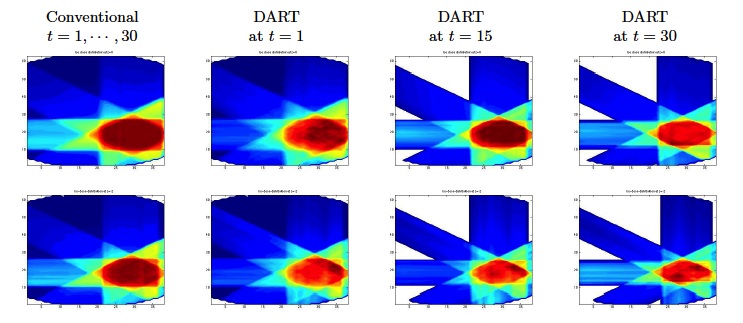글로벌 연구동향
의학물리학
![[Med Phys. ] A feasibility study of dynamic adaptive radiotherapy for nonsmall cell lung cancer.](/enewspaper/upimages/admin_20160609141226_R.bmp) 2016년 06월호
2016년 06월호
[Med Phys. ] A feasibility study of dynamic adaptive radiotherapy for nonsmall cell lung cancer.University of Washington/ 김민선*
- 출처
- Med Phys.
- 등재일
- 2016 May
- 저널이슈번호
- 43(5):2153. doi: 10.1118/1.4945023.
- 내용

AbstractPURPOSE:
The final state of the tumor at the end of a radiotherapy course is dependent on the doses given in each fraction during the treatment course. This study investigates the feasibility of using dynamic adaptive radiotherapy (DART) in treating lung cancers assuming CBCT is available to observe midtreatment tumor states. DART adapts treatment plans using a dynamic programming technique to consider the expected changes of the tumor in the optimization process.
METHODS:
DART is constructed using a stochastic control formalism framework. It minimizes the total expected number of tumor cells at the end of a treatment course, which is equivalent to maximizing tumor control probability, subject to the uncertainty inherent in the tumor response. This formulation allows for nonstationary dose distributions as well as nonstationary fractional doses as needed to achieve a series of optimal plans that are conformal to the tumor over time, i.e., spatiotemporally optimal plans. Sixteen phantom cases with various sizes and locations of tumors and organs-at-risk (OAR) were generated using in-house software. Each case was planned with DART and conventional IMRT prescribing 60 Gy in 30 fractions. The observations of the change in the tumor volume over a treatment course were simulated using a two-level cell population model. Monte Carlo simulations of the treatment course for each case were run to account for uncertainty in the tumor response. The same OAR dose constraints were applied for both methods. The frequency of replanning was varied between 1, 2, 5 (weekly), and 29 times (daily). The final average tumor dose and OAR doses have been compared to quantify the potential dosimetric benefits of DART.
RESULTS:
The average tumor max, min, mean, and D95 doses using DART relative to these using conventional IMRT were 124.0%-125.2%, 102.1%-114.7%, 113.7%-123.4%, and 102.0%-115.9% (range dependent on the frequency of replanning). The average relative maximum doses for the cord and esophagus, mean doses for the heart and lungs, and D05 for the unspecified tissue resulting 84%-102.4%, 99.8%-106.9%, 66.9%-85.6%, 58.2%-78.8%, and 85.2%-94.0%, respectively.
CONCLUSIONS:
It is feasible to apply DART to the treatment of NSCLC using CBCT to observe the midtreatment tumor state. Potential increases in the tumor dose and reductions in the OAR dose, particularly for parallel OARs with mean or dose-volume constraints, could be achieved using DART compared to nonadaptive IMRT.
Author information
Kim M1, Phillips MH2.
1Department of Radiation Oncology, University of Washington, Seattle, Washington 98195-6043.
2Departments of Radiation Oncology and Neurological Surgery, University of Washington, Seattle, Washington 98195-6043.
- 연구소개
- 방사선 치료에 반응하는 종양의 변화 예측 상태를 치료 과정에 반영하여 치료효과를 극대화 하는 방법 (dynamic adaptive radiotherapy – DART) 을 제시하는 논문입니다. 기존의 adaptive radiotherapy는 종양의 시간에 따른 변화를 고려하지 않은 상태, 즉 현재 보여지는 상태만을 고려하여 방사선 치료 플랜을 짜는 방법인데 반해서, DART는 종양의 dynamics를stochastic control framework를 이용하여, treatment planning optimization에 직접 반영하는 새로운 방법입니다. DART의 주 목적은 normal tissue 에 허용되는 방사선량 범위 내에서, 암세포의 killing을 최대화 하는 것입니다. 이 논문에 제시되는 DART는 이론적인 단계로서 임상실험으로 가기까지 많은 의학물리학자들의 연구와 노력이 필요할것으로 보입니다.
- 덧글달기







